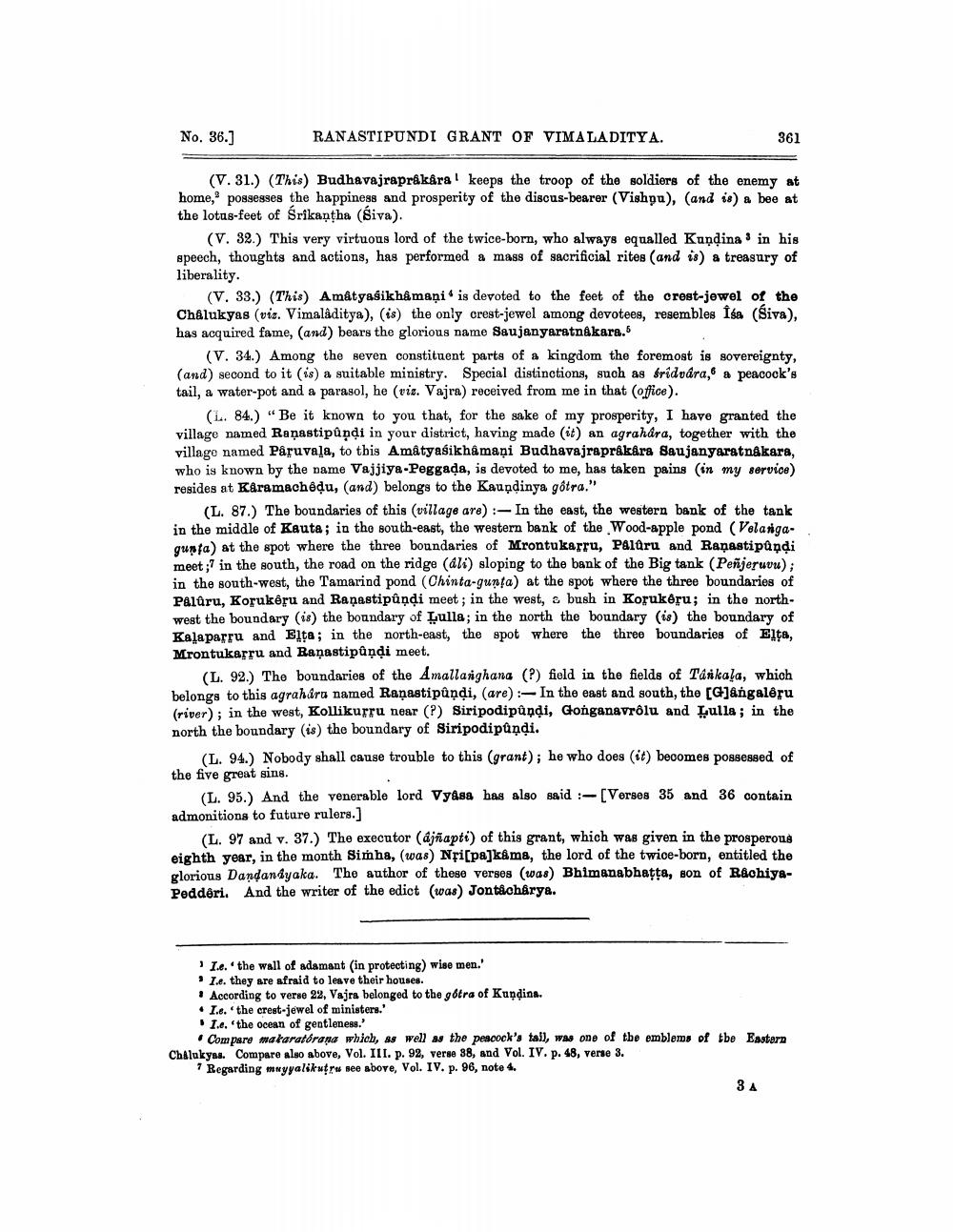________________
No. 36.]
RANASTIPUNDI GRANT OF VIMALADITYA.
361
(V. 31.) (This) Budhavajrapräkära! keeps the troop of the soldiers of the enemy at home, possesses the happiness and prosperity of the discus-bearer (Vishyu), (and is) a bee at the lotas-feet of Srikantha (Siva).
(V. 32.) This very virtuous lord of the twice-born, who always equalled Kundina: in his speech, thoughts and actions, has performed a mass of sacrificial rites (and is) a treasury of liberality.
(V. 33.) (This) Amatyagikhâmaņi is devoted to the feet of the crest-jewel of the Chalukyas (viz. Vimaladitya), (is) the only crest-jewel among devotees, resembles Isa (Siva), has acquired fame, (and) bears the glorious name Saujanyaratnakara.
(V. 34.) Among the seven constituent parts of a kingdom the foremost is sovereignty, (and) second to it (is) a suitable ministry. Special distinctions, such as Sridvara, a peacock's tail, a water-pot and a parasol, he (viz. Vajra) received from me in that office).
(i.. 84.) "Be it known to you that, for the sake of my prosperity, I have granted the village named Raņastipůņdi in your district, having made (it) an agrahara, together with the villago named Påruvala, to this Amatyaśikhâmaņi Budhavajrapråkára Saujanyaratnákara, who is known by the name Vajjiya-Peggada, is devoted to me, has taken pains (in my service) resides at Karamachôdu, (and) belongs to the Kauzdinya gôtra."
(L. 87.) The boundaries of this village are):- In the east, the western bank of the tank in the middle of Kauta; in the south-east, the western bank of the Wood-apple pond (Velangagunta) at the spot where the three boundaries of Mrontukarru, Paluru and Raņastipůndi meet; in the south, the road on the ridge (ali) sloping to the bank of the Big tank (Peñjeruvu); in the south-west, the Tamarind pond (Chinta-gunta) at the spot where the three boundaries of Paluru, Korukôru and Ranastipůndi meet; in the west, bush in Korukeru; in the northwest the boundary (is) the boundary of Lulla; in the north the boundary (is) the boundary of Kalaparru and Elta; in the north-east, the spot where the three boundaries of Elta, Mrontukarru and Ranastipundi meet.
(L. 92.) The boundaries of the Amallarghana (?) field in the fields of Tarkala, which belongs to this agrahara named Ranastipûņdi, (are) :- In the east and south, the [G]ångalêru (river); in the west, Kollikurru near (?) Siripodipundi, Gonganavrôlu and Lulla; in the north the boundary (is) the boundary of Siripodipundi.
(L. 94.) Nobody shall cause trouble to this (grant); he who does (it) becomes possessed of the five great sins.
(L. 95.) And the venerable lord Vyasa has also said :-[Verses 35 and 36 contain admonitions to future rulers.]
(L. 97 and v. 37.) The executor (ajñaptt) of this grant, which was given in the prosperous eighth year, in the month Simha, (was) Nrispajkama, the lord of the twice-born, entitled the glorious Dandandyaka. The author of these verses (was) Bhimanabhatta, son of RaohiyaPeddéri. And the writer of the edict (was) Jontacharya.
Ie.. the wall of adamant (in protecting) wise men.' • I.e. they are afraid to leave their houses.
According to verse 22, Vajra belonged to the gótra of Kundins. • I.e. the crest-jewel of ministers.' . I.e. the ocean of gentleness.'
• Compare mataratorana which, as well as the peacock's tail, was one of the emblems of tbe Eastern Chalukyas. Compare also above, Vol. III. p. 92, verse 88, and Vol. IV. p. 48, verse 3.
7 Regarding mwyyalikweru see above, Vol. IV. p. 96, note 4.
SA




